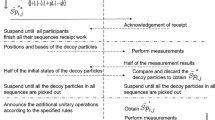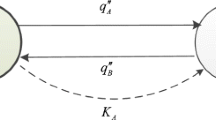Abstract
Liu et al. [Quantum Inf. Process. 12, 1797–1805 (2013)] proposed a multi-party quantum key agreement (QKA) protocol based on single particles. Their protocol can resist outsider and participant attacks. However, its qubit efficiency is low. Min et al. [Int. J. Theor. Phys. 57, 1811–1822 (2018)] put forward a multi-party QKA protocol by using G-Like states and Bell states, which has high qubit efficiency, but it cannot resist the participant attack. In this paper, combining the advantages of the two protocols, we present a multi-party QKA protocol with Bell states and single particles. The protocol can guarantee that each party has an equal opportunity to influence the final shared key and no one can determine the final key alone. Furthermore, the efficiency analysis shows that our multi-party QKA protocol is very efficient.
Similar content being viewed by others
References
Bennett, C.H., Brassard, G.: Public-key distribution and coin tossing. In: Proceedings of IEEE International Conference on Computers, Systems and Signal Processing, pp. 175–179. Ban-galore (1984)
Ekert, A.K.: Quantum cryptography based on Bell’s theorem. Phys. Rev. Lett. 67, 661–663 (1991)
Bennett, C.H.: Quantum cryptography using any two nonorthogonal states. Phys. Rev. Lett. 68, 3121 (1992)
Goldenberg, L., Vaidman, L.: Quantum cryptography. IEEE Trans. Inf. Theory 22, 644–654 (1976)
Tian, T.H., Zhang, J.Z., Li, Y.P.: A voting protocol based on the controlled quantum operation teleportation. Int. J. Theor. Phys. 55, 2303–2310 (2016)
Xu, G.B., Wen Q.Y., Qin, S.J., Yang, Y.H., Gao, F.: Quantum nonlocality of multipartite orthogonal product states. Phys. Rev. A. 93, 032341 (2016)
Jiang, D.H., Xu, Y.L., Xu, G.B.: Arbitrary quantum signature based on local indistinguishability of orthogonal product states. Int. J. Theor Phys. https://doi.org/10.1007/s10773-018-03995-4 (2019)
Jiang, D.H., Wang, X.J., Xu, G.B., Lin, J.Q.: A denoising-decomposition model combining TV minimisation and fractional derivatives. East Asia J. Appl. Math. 8, 447–462 (2018)
Bennett, C.H., Wiesner, S.J.: Communication via one- and two- particle operators on einstein-podolsky-rosen states. Phys. Rev. Lett. 69, 2881–2884 (1992)
Deng, F.G., Long, G.L.: Bidirectional quantum key distribution protocol with practical faint laser pulses. Phys. Rev. A 70, 012311 (2004)
ElAllati, A., ElBaz, M., Hassouni, Y.: Quantum key distribution via tripartite coherent states. Quantum Inf. Process. 10, 289–602 (2011)
Gottesman, D.: Theory of quantum secret sharing. Phys. Rev. A 61, 042311 (2000)
Karlsson, A., Koashi, M., Imoto, N.: Quantum entanglement for secret sharing and secret splitting. Phys. Rev. A 59, 162–168 (1999)
Zhang, Z.J., Li, Man, Z.X.: Multiparty quantum secret sharing. Phys. Rev. A 71, 044301 (2005)
Liu, B., Gao, F., Wen, Q.Y.: Eavesdropping and improvement to multiparty quantum secret sharing with collective eavesdropping-check. Int. J. Theor. Phys. 51, 1211–1223 (2012)
Deng, F.G., Long, G.L., Liu, X.S.: Two-step quantum direct communication protocol using the einstein-podolsky-rosen pair block. Phys. Rev. A 68, 042317 (2003)
Deng, F.G., Long, G.L.: Secure direct communication with a quantum one-time pad. Phys. Rev. A 69, 052319 (2004)
Diffe, W., Hellman, M.: New directions in cryptography. IEEE Trans. Inf. Theor. 22, 644–654 (1976)
Liu, W., Wang, Y.B., Jiang, Z.T.: An efficient protocol for the quantum private comparsion of equality with w states. Opt. Commun. 284, 3160–3165 (2011)
Sun, Z.W., Long, D.Y.: Quantum private comparison protocol based on cluster states. Int. J. Theor. Phys. 52, 212–218 (2013)
Hsueh, C.C., Chen, C.Y.: Quantum key agreement protocol with maximally entangled states. In: Procssdings 14th Information Security Conference (ISC 2004), pp 236–242. National Taiwan University of Science and Technology, Taipei (2004)
Xu, G.B., Wen, Q.Y., Gao, F., Qin, S.J.: Novel multiparty quantum key agreement protocol with GHZ states. Quantum Inf. Process. 13, 2587–2594 (2014)
Shi, R.H., Zhong, H.: Multi-party quantum key agreement with Bell states and Bell measurements. Quantum Inf. Process. 12, 921–932 (2013)
Chong, S.K., Hwang, T.: Quantum key agreement protocol based on BB84. Opt. Commun. 283, 1192–1195 (2010)
Yin, X.R., Ma, W.P., Liu, W.Y.: Three-party quantum key agreement with two-photon entanglement. Int. J. Theor. Phys. 52, 3915–3921 (2013)
Liu, B., Gao, F., Huang, W., Wen, Q.Y.: Multiparty quantum key agreement with single particles. Quantum Inf. Process. 12, 1797–1805 (2013)
Huang, W., Wen, Q.Y., Liu, B., Gao, F., Chen, H.: Deterministic secure quantum communication with collective detection using single photons. Int. J. Theor. Phys. 51, 2787–2797 (2012)
Shen, D.S., Ma, W.P., Wang, L.L.: Two-party quantum key agreement with four-qubit cluster states. Quantum Inf. Process. 13, 2313–2324 (2014)
He, Y.F., Ma, W.P.: Quantum key agreement protocol with four-qubit cluster states. Quantum Inf. Process. 14, 3483–3498 (2015)
He, Y.F., Ma, W.P.: Two-party quantum key agreement against collective noise. Quantum Inf. Process. 15, 5023–5035 (2016)
He, Y.F., Ma, W.P.: Two quantum key agreement protocols immune to collective noise. Int. J. Theor. Phys. 56, 328–338 (2017)
Zhou, N., Zeng, G., Xiong, J.: Quantum key agreement protocol. Electron. Lett. 40, 1149 (2004)
Min, S.Q., Chen, H.Y., Gong, L.H.: Novel multi-party quantum key agreement protocol with g-like states and bell states. Int. J. Theor. Phys. 57, 1811–1822 (2018)
Sun, Z.W., Zhang, C., Wang, P., Yu, J.P., Zhang, Y., Long, D.Y.: Multi-party quantum key agreement by an entangled six-qubit state. Int. J. Theor. Phys. 55, 1920–1929 (2016)
Sun, Z.W., Yu, J., Wang, P.: Efficient multi-party quantum key agreemrnt by cluster states. Quantum Inf. Process. 15, 373–384 (2016)
Zhu, Z.C., Hu, A.Q., Fu, A.M.: Participant attack on three-party quantum key agreement with two-photon entanglement. Int. J. Theor. Phys. 55, 1–7 (2016)
Deng, F.G., Long, G.L., Wang, Y., Xiao, L.: Increasing the efficiencies of random-choice-based quantum communication protocols with delayed measurement. Chin. Phys. Lett. 21, 2097 (2004)
Gisin, N., Fasel, S., Kraus, B., Zbinden, H., Ribordy, G.: Trojan-horse attacks on quantum-key-distribution system. Phys. Rev. A 73, 022320 (2006)
Wang, Z., Wang, X.H., Li, Y.X., Huang, X.: Stability and Hopf bifurcation of fractional-order complex-valued single neuron model with time delay. Int. J. Bifurcat. Chaos 27(13), 1750209 (2017)
Wang, X.H., Wang, Z., Huang, X., Li, Y.X.: Dynamic analysis of a fractional-order delayed SIR model with saturated incidence and treatment functions. Int. J. Bifurcat. Chaos 28(14), 1850180 (2018)
Zhang, T.Q., Meng, X.Z., Zhang, T.H.: Global analysis for a delayed siv model with direct and environmental transmissions. J. Appl. Anal. Comput. 6(2), 479–491 (2016)
Meng, X.Z., Wang, L., Zhang, T.H.: Global dynamics analysis of a nonlinear impulsive stochastic chemostat system in a polluted environment. J. Appl. Anal. Comput. 6(3), 865–875 (2016)
Zhao, W.C., Li, J., Meng, X.Z.: Dynamical analysis of SIR epidemic model with nonlinear pulse vaccination and lifelong immunity. Discrete Dyn. Nat. Soc. 2015, 848623 (2015)
Cui, Y.J., Zou, Y.M.: An existence and uniqueness theorem for a second order nonlinear system with coupled integral boundary value conditions. Appl. Math. Comput. 256, 438–444 (2015)
Lin, J., Hwang, T.: New circular quantum secret sharing for remote agents. Quantum Inf. Process. 12, 685–697 (2013)
Cabellon, A.: Quantum key distribution in the Holevo limit. Phys. Rev. Lett. 85, 5635 (2000)
Acknowledgements
This work is supported by the National Natural Science Foundation of China (61402265) and the Fund for Postdoctoral Application Research Project of Qingdao (01020120607).
Author information
Authors and Affiliations
Corresponding author
Additional information
Publisher’s Note
Springer Nature remains neutral with regard to jurisdictional claims in published maps and institutional affiliations.
Rights and permissions
About this article
Cite this article
Liu, HN., Liang, XQ., Jiang, DH. et al. Multi-Party Quantum Key Agreement Protocol with Bell States and Single Particles. Int J Theor Phys 58, 1659–1666 (2019). https://doi.org/10.1007/s10773-019-04063-1
Received:
Accepted:
Published:
Issue Date:
DOI: https://doi.org/10.1007/s10773-019-04063-1




